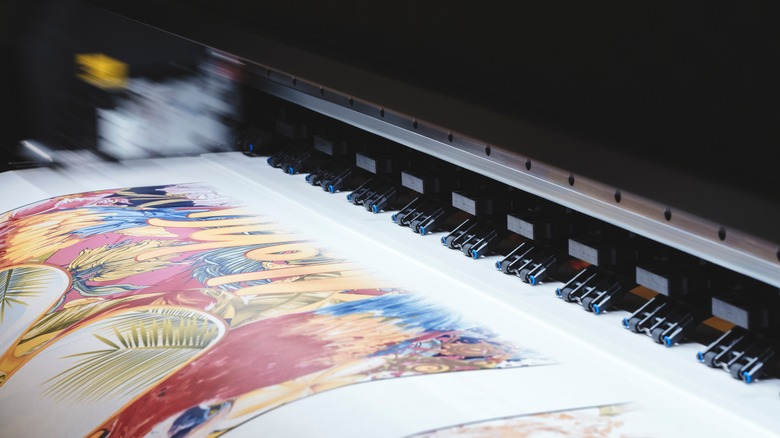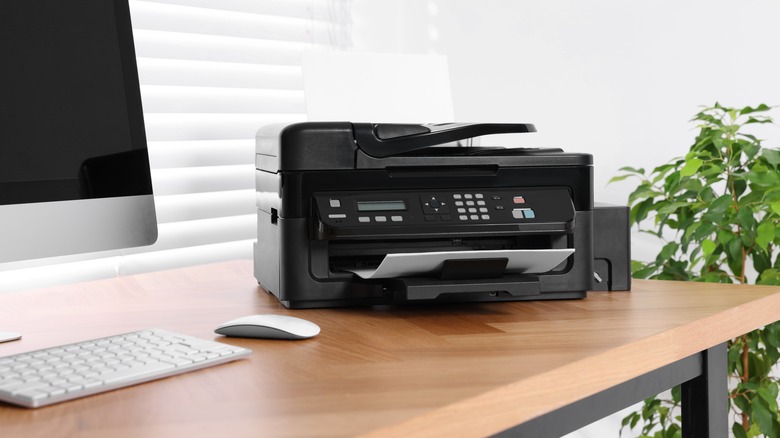Can A Printer Print White Ink?
While we very much live in a digital world these days, many of us still rely on printed materials to at least some extent. That's why printers still sit alongside other must-have gadgets in home offices around the world. While the go-to color for most printing tends to be black, sometimes you want a splash of color, or even no color at all. You most likely know how to switch between black and color printing, but what if you want to print in white? If you've ever tried, you've likely run into a problem: most standard home and office printers can't print in white. That's because most standard printers operate using the CMYK color model — cyan, magenta, yellow, and black. These traditional printers blend transparent inks on white paper to reproduce colors. With this setup, there's no white ink involved. Instead, what appears as white on the page is just the paper itself, left unprinted.
In fact, for a long time, digital printing in white ink just couldn't be done because the technology didn't exist. However, times have changed thanks to advances in printing technology; printing in white ink is now a reality, at least in certain types of printers. If you're wondering why anyone would go to the trouble of printing with white ink, it's because it makes it possible to produce vibrant, high-contrast designs on dark or transparent materials, something you just can't do with a standard CMYK printer. As useful as it can be, white ink still isn't something you'll find in a typical desktop printer, and there are a few good reasons why.
Why white ink isn't standard in most printers
While printer technology has advanced, white ink still doesn't work with most standard laser and inkjet printers found in homes and offices. Even the best laser printers designed for use at home can't print white ink. The main reason is that white ink is more difficult to work with, and everyday printers aren't built to use it. One thing that makes printing with white ink especially challenging is that it's much thicker than other inks because it contains heavy pigments like titanium dioxide. These particles are what give white ink its opacity, but they also make it more likely to clog print heads or settle in the cartridge after repeated use. Specialized equipment is needed to keep these particles suspended properly, something that standard printers aren't designed to handle.
Something else that complicates the use of white ink in standard printers is that it tends to dry faster and form a firmer layer on substrates, which increases the likelihood of nozzle blockages. Printers designed for printing white ink often come equipped with features like ink circulation systems and require more frequent maintenance to mitigate these issues. The additional requirements of white ink printing make it more complex and costly, which has limited its use mainly to specialized industries like packaging, signage, and apparel printing. If you're printing at home, using white paper usually makes the most sense when you want to incorporate white into a design.
When and how white ink is used
When it comes to printing on dark or transparent materials, white ink plays an important role by acting as a base layer that helps other colors stand out. You'll most often see this technique used in like packaging, signage, and apparel printing, where the goal is to achieve vibrant, high-contrast designs that maintain their integrity across various substrates. While the printers found in our ranking of major printer brands don't use white ink, that's because they're designed for home and office use, where printing on white paper is the norm. However, if you need to print eye-catching designs on materials like kraft paper or clear labels, white ink can work wonders by ensuring that the colors remain true and legible. The same is true when creating window decals and displays on transparent surfaces; white ink makes it possible to create bold graphics that get people's attention.
You've likely seen white ink used in the apparel industry, but didn't notice. That black T-shirt with bright, full-color artwork that you love was most likely created using white ink as a base layer to make the colors stand out. It takes a specialized printer, like a UV printer or white toner laser printer, to handle white ink. For example, UV printers can print directly onto materials like plastic, glass, or metal and use white ink as a base to make colors look bright and accurate on clear surfaces. On the other hand, with a white toner laser printer, you can swap the standard black toner for white to print white graphics or text onto dark-colored paper, labels, and other materials. You'll also find white ink in DTG printers, which are often used to print colorful designs on dark T-shirts and hoodies.


